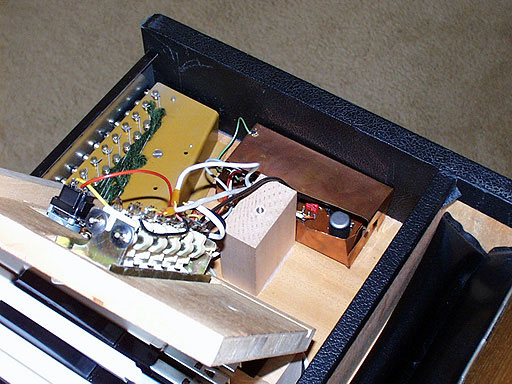[Yeah, this page needs some updating.]
A small collection of resources, notes and modifications for one of my favorite instruments, the Hohner Clavinet.
Resources
What Do the Switches Do?
Shielding
Future Projects
[Yeah, this page needs some updating.]
A small collection of resources, notes and modifications for one of my favorite instruments, the Hohner Clavinet.
Resources
What Do the Switches Do?
Shielding
Future Projects
|
|
Clavinet.com The best source for Clavinet information, schematics, replacement pads, replacement strings, a bulletin board, and lots more. Very impressive. |
|
|
Melbourne Music Nice music store web site over on the other side of the planet. They have replacement Clavinet parts and strings. |
|
|
Classic Keys, the Hohner Clavinet, Pianet and Cembalet by Brad Coates, Australian Music Magazine, 1997. An article available at Melbourne Music's web site. |
|
|
Hohner, Germany Hohner's main web site. No mention of the Clavinet, unfortunately. |
|
|
Hohner, USA Hohner's USA web site. No mention of the Clavinet here either. |
|
also Numerous Complaints Music Atlanta, Georgia, 404 351-4422, complain@mindspring.com Replacement parts, advice and service. |
The labeling on the ABCD switches is mighty nonintuitive.
So, here's what they do:
Left switch
(C/D)Right switch
(A/B)Pickup function down down "Neck" pickup; a warm sound. down up "Bridge" pickup; a bright brash sound. up up Both pickups; a very full sound. up down Both pickups on, out of phase; the fundamental cancels somewhat and you're left with a pretty thin sound.
Doesn't make much sense, eh? A good way to remember it is to think of the left switch as choosing between one pickup and two.
It's actually a somewhat clever arrangment because it gives you all four basic combintations of two pickups with two two-position switches.
One bug with the Clavinet D6 is that it's completely unshielded. What were they thinking? Well, the pickups are pretty low impedance devices but the beast is still very susceptible to noise.
It's easy to correct this by building a little enclosure out of copper sheet. Get some that's thin enough to cut with tin snips, fashion it into a box shape of the appropriate size, mount the Clavinet preamp inside, screws through the copper, and connect the copper to ground (green wire below).
Here is a photo of my Clavinet with the shielding modification and the shield pried open a little bit for a better view.
I understand that there are some manufacturing variations on the Clavinet D6, and that the preamp is mounted very differently on some units.

I've been thinking about improvements I could make to the Clavinet. Clavinet hotrodding is pretty low on my list of personal priorities right now, but here are some of my ideas for this future project:
Stereo Clavinet. The obvious way is to put the neck pickup on one channel and the bridge pickup on the other channel similar to the Rick-O-Sound feature on Rickenbacker deluxe model guitars. A possible variation is to have neck+bridge on one channel and neck-bridge on the other channel. Another possibility is to tap off the six individual coils from each of the pickups and pan the keyboard across the stereo image.
A better preamp, balanced outputs.
Better tone controls to replace the binary EQ switches.
Pickup mixing and animated pickup mixing. I've got a lot to say about this but it's going to have to wait for a separate article.
Should the battery be replaced with a proper power supply? While a battery is really convenient for setting up quickly when you're playing out, the chance of leaving the unit on and draining the battery is pretty high.